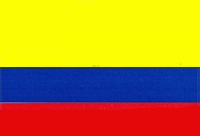What is Vallenato?
By Luis A. Del Castillo Cadavid
and Luis L. Moya, Ph.D.
Most people would simply describe "Vallenato" as a type of
 music from the northern coast of Colombia, more precisely from Valledupar, capital of the state of Cesar.
To a certain degree this may be true since Vallenato is a combination of three basic musical instruments
such as an accordion, a bongo, and a guiro producing as a result a unique type of music that after many years
of being confined to that region it expanded nationwide and later crossed many borders of Spanish speaking
countries as well as selected European and North American cities. The word "vallenato" comes from the phrase "nato
del Valle" (native of the Valley) a common answer given by people of that region when asked where they are from.
music from the northern coast of Colombia, more precisely from Valledupar, capital of the state of Cesar.
To a certain degree this may be true since Vallenato is a combination of three basic musical instruments
such as an accordion, a bongo, and a guiro producing as a result a unique type of music that after many years
of being confined to that region it expanded nationwide and later crossed many borders of Spanish speaking
countries as well as selected European and North American cities. The word "vallenato" comes from the phrase "nato
del Valle" (native of the Valley) a common answer given by people of that region when asked where they are from.
The vallenato music has four basic rhythms: son, paseo, merengue, and puya. These are differentiated from each
other by the speed and way the instruments are played.
Son
 In son, the slowest and most peculiar rhythm of all, the coordination of the three instruments is supremely
important to be able to maintain the rhythm and melody. It can be differentiated from the others by listening
to the accordion, since its seemingly individual playing of notes should always be accompanied by that of the
basses. The playing of the accordion is so complex that one can almost say that the accordion player carries two
performances in one melody: that of the right hand and that of the left hand keyboard or basses.
In son, the slowest and most peculiar rhythm of all, the coordination of the three instruments is supremely
important to be able to maintain the rhythm and melody. It can be differentiated from the others by listening
to the accordion, since its seemingly individual playing of notes should always be accompanied by that of the
basses. The playing of the accordion is so complex that one can almost say that the accordion player carries two
performances in one melody: that of the right hand and that of the left hand keyboard or basses.
Paseo
It is the most played and marketed rhythm in the vallenato music. It is a little quicker than son and is divided
into two kinds: slow paseo and fast paseo. The slow paseo is generally romantic although there are occasions in which it
 is composed in reference to a friend, a town and sometimes to regional ethnic customs. The fast paseo as its own name
indicates it, is a little quicker and is rarely romantic. Generally, this is the one that is used to make the accordion
light up and take a key part in the song. Many people cannot distinguish it from merengue, another fast tempo style,
because of the speed in which it is played. The common denominator among the two paseos is the rhythm that each instrument
carries, although it varies in speed depending on the type of paseo.
is composed in reference to a friend, a town and sometimes to regional ethnic customs. The fast paseo as its own name
indicates it, is a little quicker and is rarely romantic. Generally, this is the one that is used to make the accordion
light up and take a key part in the song. Many people cannot distinguish it from merengue, another fast tempo style,
because of the speed in which it is played. The common denominator among the two paseos is the rhythm that each instrument
carries, although it varies in speed depending on the type of paseo.
When listening attentively to any paseo, the guiro can be easily differentiated from the rest of the rhythms.
Merengue
Generally it is a much more happier sound than the two previous styles and also faster. Many say that its origin is
traced to Central America or the Caribbean Islands due to its similarity with the Dominican merengue. In fact this
characteristic can be very helpful when trying to differentiate it from the other rhythms. The merengue is danced to
in a way similar to the Dominican pattern and like the paseo is also well marketed in the recording industry. Although
it is not a romantic rhythm by design, many merengues are written for and about women and reveal love stories.
Puya
This is the fastest rhythm of all and at the same time the most complex; however is the easiest to grasp. The accordion,
the bongo, and the guiro need to be played with plenty of skills due to the speed of the rhythm. One can say that this
rhythm was always utilized to express the humorous side of the people. Its lyrics generally refer to the folklore itself
and are rarely sad since its fast speed does not lend itself to it. Although many people tend to confuse the Vallenato
with other rhythms which, at times, are also played with the accordion, one must keep in mind that "not everything that
is played with an accordion is called Vallenato."
The fact is, that vallenato is more than music: it is livelihood as well as romantic expressions capable of touching anyone
who knows and understands the importance of this cultural treasure. The "romancero" vallenato is a man for whom the woman
and his native town with all its customs are the most important things in life. The woman that the "romancero" is in love
with is the focal point of almost all his songs and many times these are composed to be sung at midnight in front of the
bedroom window of the beloved woman' s house. The "serenata vallenata" (the vallenato serenade) is a custom that has lasted
for many years and although it is no longer as common as it was in the past, it is still practiced among the people of small
towns or provinces. Thus, Roberto Calderón, a respected vallenato songwriter, testifies to this tradition in his famous song
"Luna Sanjuanera" (Moon of Sanjuan).
..............Ask anyone in the Latin music arena of the United States about el vallenato as it is commonly known the
most Popular music emanating from Colombia since the 1970's, and they would immediately associate it with the modem sounds of
Carlos Vives and to a certain extent with the Abriendo Puertas CD of Gloria Estefan. Together Carlos and Gloria have
brought unprecedented vallenato awareness to many Spanish and non Spanish speaking music enthusiasts around the world. They
have internationalized this folkloric, catchy; and beautiful music from a region called Valle de Upar, a large valley located
in the northeastern part of Colombia South America. But, what is vallento?
Background
The vallenato music, as it is known today, is said in have been influenced by a combination of African European and
Colombian rhythm and folkloric sounds. At first, native people from Valle de Upar played their music with flutes called
gaitas made of bamboo and African drums made of hollow wood with goat skins secured by wooden rings and strings.
It is estimated
that a century after the invention of the accordion in 1829, Europeans introduced the German Hohner accordion to the northern
coast of Colombia where it was primarily used to play European music. Fortunately, the famous German instrument, now most commonly
known as the acordeón vallenato, found its way to Valle do Upar where it was adopted as part of the vallenato folklore.
According to vallenato historian Tomás D. Gutiérrez Hinojosa (1992: Cultura vallenata: origen, teoría y pruebas ), the
European accordion migrated to Valle the Upar not to create music but to be physically and culturally transformed by the vallenato
musician so that it can be used to interpret the different vallenato styles.
Within the vallenato music and folklore there are basically four rhythm styles puya, merengue, son and paseo.
The son and paseo have that slowest tempo of the four styles but the paseo is perhaps the most popular or most commercially marketable music.
A Vallenato Group
Typically, vallenato music is played with un acordeón vallenato (usually, though not necessarily, a German accordion), una
caja vallenata (a larger version of the bongo), and una guacharaca (a guiro type of instrument made of a special bamboo cane).
Commercially, however a vallenato group consists of an accordian player (un acordeonero), a singer (un contante), two
harmony singers (coros), a bongo player (un cajero), a guiro player (un guacharaquero), a conga player (un conguero),
a bass player (un bajista), a guitar player (un guitarrista), a timbales player (un timbalero).
The most modern or techno vallenato sound may include full drum sets, keyboards, and wind instruments depending on the main singer's
musical and cultural orientation. For Example, the techno vallenato music that is interpreted by Carlos Vives,
Tulio Zuluaga and Gloria Estefan contains some of these sounds. However the purist form of vallenato music is represented by the works
of Los Hermanos, Jorge Oñate, and Diomedes Díaz among the most popular ones. Today there are hundreds of vallenato groups not only
in the region of the Valle de Upar but throughout the major cities of Columbia and around the world.

